The Truth About Pregnancy and Kettlebell Training An Interview with Natalie Lynch, HKC, RN BSN
By Adrienne Harvey, SrPCC, RKC-II, CK-FMS
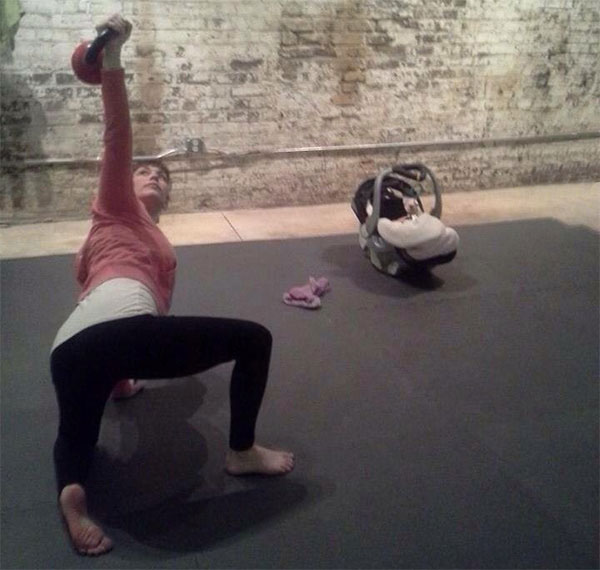
Dragon Door: How did you get involved with kettlebells?
Natalie Lynch: I was introduced to
kettlebells about 10 years ago when Nick started using them at the studio. Since we're married, we often trained together doing an I-go-you-go sort of thing. I also would go to group classes. I'm a registered nurse and work with the clients at the gym on their nutrition, so it was nice to be able to attend classes with our mutual clients and get a workout.
Dragon Door: When did you start teaching nutrition?
Natalie Lynch: Nutrition became a major focus for me after I graduated from nursing school in 2009. Nutrition education is my role at the studio, but I also work as a pediatric nurse.
Dragon Door: Before our interview, Nick mentioned that you've managed to stay consistent with your kettlebell training throughout having kids. What inspired you to stick with your training?
Natalie Lynch: Before having our first child in 2013, I really believed that if you aren’t already dedicated to physical fitness or exercise prior to having kids, then it must be very difficult to establish good habits after the kids come along. And wow, that been absolutely true for me! Before the kids, I probably worked out two hours a day, five days a week. Now, I hope to get maybe thirty minutes a day, three days a week—believe it or not, I still really struggle to make that happen! There are two small people in my life that literally depend on me for their every need right now, which is a lot of responsibility. I stay committed to fitness by really making my workouts a priority.
I’ve also changed my expectations.I used to have more defined goals for my training, like working towards a certification, or maybe even just an aesthetic goal. But, I realized that I'm training because it makes me feel better and calmer—and everyone in my household benefits from that! I trained throughout my entire pregnancy with my son in 2012-2013. During that same time, I saw a video I’ll never forget: a woman doing a
28kg kettlebell get-up only 4-6 weeks after having a caesarian birth. I thought it was awesome when I saw it, but after I actually had a baby I realized that at 4-6 weeks out, I was nowhere near that video. And really, how many of us would be? I was so far from that level that I felt like a failure. Then, I realized that the video wasn’t the norm. The woman in the video was an outlier compared to an average postpartum mom.
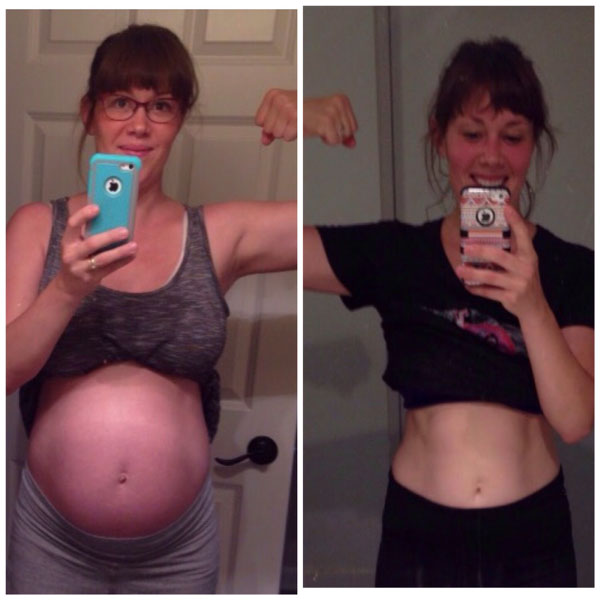
We need to show women what's really possible for post-partum recovery and fitness. I think of it as more of a tortoise vs. hare situation. If you recover the way you're supposed to recover, it might take a lot longer but the long-term gains will be greater. Progressing slowly helps to prevent injuries or aggravating common birth injuries that we don't always hear about in the fitness world.
Our community here at the gym and some of the mom groups in Milwaukee seem to enjoy my honesty on this topic. They see me as someone who is fit—as fitness is a huge part of my life—yet who still struggles with certain physical things after having babies. Talking honestly and openly about it has been really refreshing for so many women. Because unless you're an outlier, then I think it's pretty typical to feel the way I do about training after having a baby. Conditions like rectus diastasis, perineal tears, and uterine prolapse are common birth injuries. Only after having babies and talking to women, I didn’t realize how many women feel limited in their fitness for these reasons.
Dragon Door: How else are you using your training to recover and inspire others?
Natalie Lynch: My daughter is now seven months old. Before I had kids I thought seven months was a long time, nearly a year, and that it would be easy by now. But in reality, I'm still breast feeding her about every three to four hours and she's still waking up once or twice a night. I'm at about 30% of where I want to be with my training. I've always really struggled to keep up my milk supply if I work out too hard, despite increasing caloric and fluid intake.
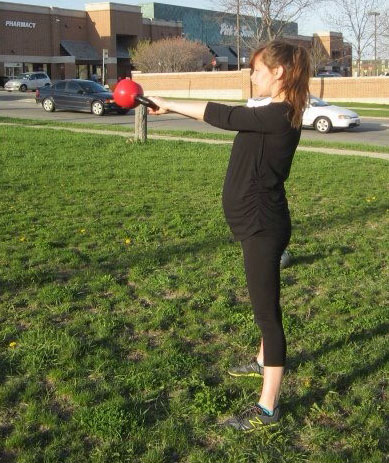
Right now, I’m still not able to train in certain ways, like doing a snatch test or distance running—even though I really like both of those things. This isn’t the case for every woman, but it is the reality for me. I hear phrases like "I can't wait to have my body back" from women who are pregnant, but the giving of my body lasts for quite a while after the baby is born. I don’t think most women expect or even realize that fact until they’ve had a baby—at least I didn’t.It's been a slow process and I'm definitely the "tortoise" in the tortoise and the hare situation! But I feel good and I continue to make working out a priority—for my
physical health, and also my mental and emotional health.
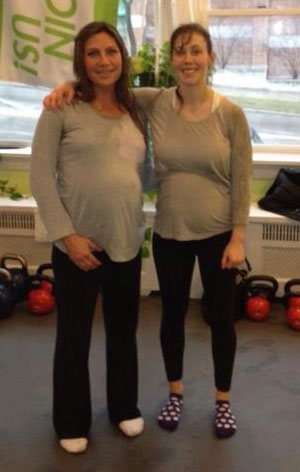
Most of the exercises I am doing right now focus on posture since I feel like I am constantly in a "mom-slump" position from leaning forward, holding a baby. So I am doing a lot of get-ups and presses. Just in the last three months I've added squatting with weight to my program. So, it's been slow. But I am still having fun, enjoying it, and still moving—I think that’s what’s most important for people. It’s bringing me fulfillment, even though I might not be the best, strongest or the fastest in our classes. Working out is still benefitting my life by helping me lose weight, calming me, and bringing me happiness and joy.
During pregnancy, they say not to lift more than twenty pounds. I thought this was strange since I had a two year old at the time who weighed more than that—and I would pick him up all day, every day. So, why couldn’t I work out safely with more than twenty pounds? Even though I chose not to listen to that guideline, I did listen to my body. I found creative ways to use the kettlebell during pregnancy and made modifications as necessary. As far as post partum recovery goes, I’ve stuck with exercises that help me maintain good posture and combat the fact that I am constantly leaning over or rounding forward when I'm nursing or snuggling a baby.
Specifically, I’ve enjoyed doing
get-ups and pausing for a press at each stage—that has been my number one favorite exercise. Sometimes I’ll just set the timer for twenty minutes and do that combination for time. I’m making sure to be aware of my own limitations right now, and my top priority is making sure I’m able to feed the baby. So, high intensity cardio just isn't in the cards yet. I’ve had to accept that's where I am in life and have modified my training accordingly.
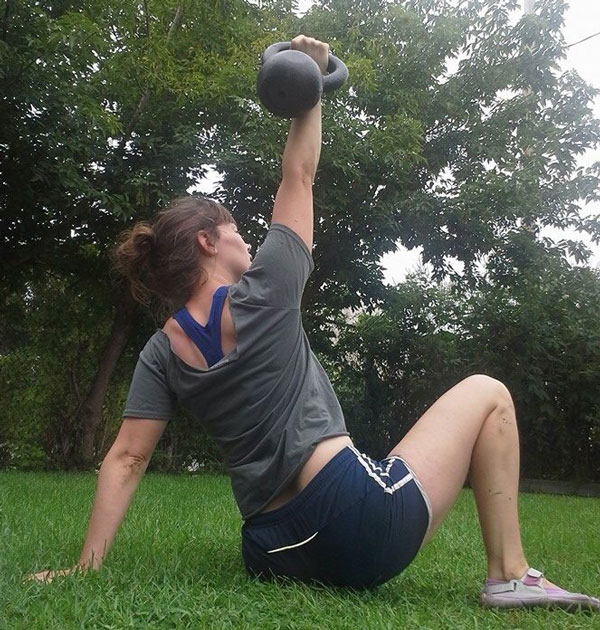
Dragon Door: That's important to modify training to fit the situation. Before our call, I really liked what you said about connecting with everyday people who may or may not have specific athletic aspirations. Why do you recommend kettlebells for people in the general population?
Natalie Lynch: I use kettlebells and recommend them because they are the most efficient tool. I can set the timer for 15-20 minutes and I’ll be really smoked at the end of that. I don't think that any other mode of exercise I've practiced yields those same results.
Nick instructs with a lot of attention to form, which I think is very important right now. I am able to concentrate on my form which keeps me from injuring anything or impeding my progress. With kettlebells, I’ve found that I can only increase the weight if I am using proper form—the exercises just don’t feel right otherwise. If I’m not swinging correctly, it’s obvious right away and I feel the same is true for many of the other exercises. It’s easy to listen to your body when you use a kettlebell.
Dragon Door: Even though you've mostly answered this already, are you working towards any specific goals at the moment?
Natalie Lynch: While my priority right now is feeding the baby, ultimately I am going to do an
RKC Certification. I've been saying that for four years, but then I had two babies so it just hasn’t worked out yet.
I went to the
HKC we hosted here in Milwaukee which Andrea Du Cane led in 2014. She was very helpful at the time, because I had had rectus diastasis—the abdominal wall separation—from carrying my first born. Andrea modified exercises during the HKC for me. She even gave me some more movements to help me make a full recovery.
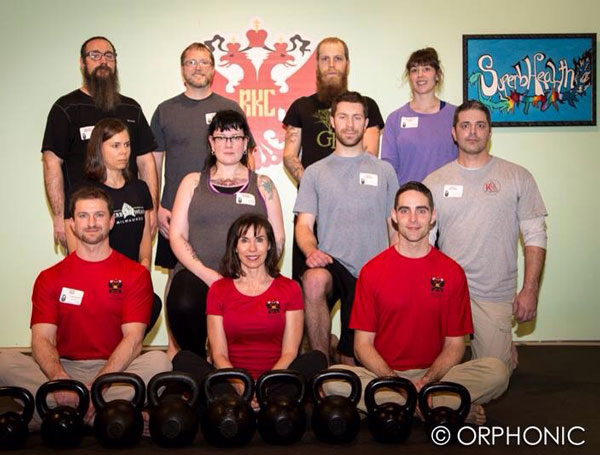
It’s funny, there are all these experiences I’ve had through childbearing. At first I thought I was the only one. As it turns out, I’ve met so many
women with similar experiences. But, people should know about these things ahead of time! It's really nice to talk honestly, because for most people, carrying a baby is more than just a nine month experience—and that’s ok!
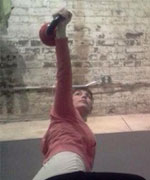 Natalie Lynch, HKC, RN BSN teaches nutrition at Superb Health in Milwaukee, WI. She can be contacted through the Superb Health website at http://superbhealthmke.com.
Natalie Lynch, HKC, RN BSN teaches nutrition at Superb Health in Milwaukee, WI. She can be contacted through the Superb Health website at http://superbhealthmke.com.
Back